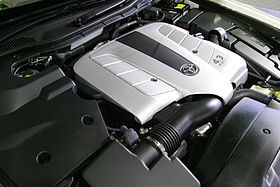Toyota UZ engine
| Toyota UZ Engine | |
|---|---|
 |
|
| Overview | |
| Manufacturer | Toyota Motor Corporation |
| Production | 1989–2013 |
| Combustion chamber | |
| Configuration | DOHC 90° V8 |
| Chronology | |
| Predecessor | Toyota V engine |
| Successor | Toyota UR engine |
The Toyota UZ engine family is a 32-valve quad-camshaft V8 piston engine series used in Toyota's luxury offerings and sport utility vehicles. Three basic versions have been produced, the 1UZ-FE, 2UZ-FE, and 3UZ-FE. Production spanned 24 years, from 1989 to mid 2013, ending with the final production of the 3UZ-FE-powered Toyota Crown Majesta I-FOUR. Toyota's UZ engine family was replaced by the UR engine family.
The 4.0 L (3,969 cc or 242.2 cu in) all-alloy 1UZ-FE debuted in 1989 in the first generation Lexus LS 400/Toyota Celsior and the engine was progressively released across a number of other models in the Toyota/Lexus range. The engine is oversquare by design, with a bore size of 87.5 mm (3.44 in) and stroke of 82.5 mm (3.25 in). It has proved to be a strong, reliable and smooth powerplant with features such as 6-bolt main bearings and belt-driven quad-camshafts. The water pump is also driven by the cam belt. The connecting rods and crankshaft are constructed of steel. The pistons are hypereutectic.
Its resemblance to a race engine platform (6 bolt cross mains and over square configuration) was confirmed in 2007 by David Currier (in an interview with v-eight.com), vice president of TRD USA, stating that the 1UZ platform was based on CART/IRL engine design. It was planned to be used on GT500 vehicles, however its subsequent use in the Daytona Prototype use had not been planned.
In its standard, original trim with 10:1 compression, power output is 191 kW (251 hp), torque of 353 N·m (260 lb·ft).
The engine was slightly revised in 1995 with lighter connecting rods and pistons and an increased compression ratio to 10.4:1 resulting in peak power of 195 kW (261 hp) at 5,400 rpm and torque of 365 N·m (269 lb·ft) at 4,400 rpm.
In 1997, Toyota's VVT-i variable valve timing technology was introduced along with a further compression ratio increase to 10.5:1, bumping power and torque to 216 kW (290 hp) at 5,900 rpm and 407 N·m (300 lb·ft) at 4,100 rpm. For the GS400, output was rated at 224 kW (300 hp) at 6,000 rpm and 420 Nm (310 lb·ft) at 4,000 rpm.
...
Wikipedia
